NCERT Solutions for Class 5 Maths Chapter 3 How Many Squares?
NCERT Solutions for Class 5 Maths Chapter 3 Page 34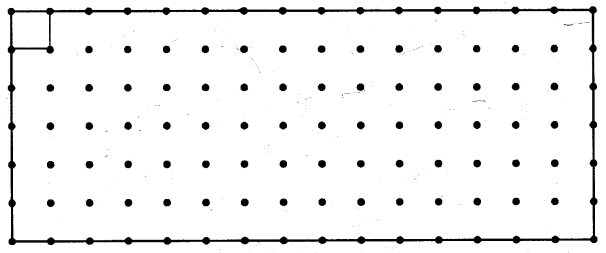
1.Measure the side of the red square on the dotted sheet. Draw here as many rectangles as possible using 12 such squares.
• How many rectangles could you make?
Ans.The side of the square is 1 centimetre.
Following figure shows the possible rectangles using 12 such squares.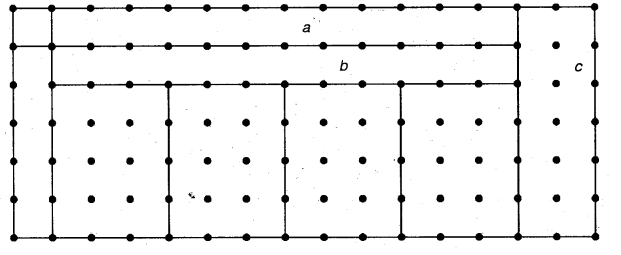
There are 7 rectangles.
2 rectangles are of size 1 x 12 centimetre.
1 rectangle is of size 2x 6 centimetre.
4 rectangles are of size 3 x 4 centimetre
Hence, number of rectangles = 2 + 1 + 4 = 7
2.Which of these rectangles has the longest perimeter?
Ans. Perimeter of rectangle measuring 1 x 12 cm
= 2 (length + breadth)
= 2(1 + 12)
= 2 x 13 = 26 cm
Perimeter of rectangle measuring 2×6 cm = 2 (length + breadth)
= 2 (2 + 6)
= 2×8 = 16 cm
Perimeter of rectangle measuring 3×4 cm = 2 (length + breadth)
= 2(3 + 4)
= 2 x 7 = 14 cm
Hence, the rectangle measuring 1 x 12 cm has the longest perimeter.
3.Which of these rectangles has the smallest perimeter?
Ans. The rectangle measuring 3 x 4 cm has the smallest perimeter.
NCERT Solutions for Class 5 Maths Chapter 3 35
Measure Stamps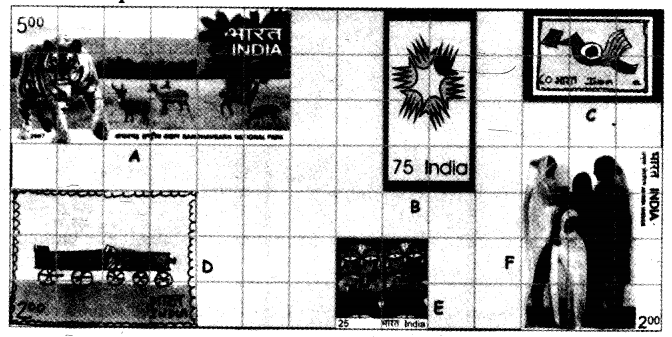
Stamp D covers 12 squares. Each square is of side 1 cm. So the area of stamp D is 12 square cm.
Look at these interesting stamps.
(а)How many squares of one centimetre side does stamp A cover?
Ans. Area = length x breadth
= 6 x 3 = 18 square cm
•And stamp B?
Ans. Area = length x breadth
= 4 x 2 = 8 square cm
(b)Which stamp has the biggest area?
Ans. Stamp A has the biggest area.
•How many squares of side 1 cm does this stamp cover?
Ans. This stamp covers 18 squares of side 1 cm.
•How much is the area of the biggest stamp?
Ans. 18 square cm.
(c)Which two stamps have the same area?
Ans. Stamp D and F have the same area.
•How much is the area of each of these stamps?
Ans. The area of stamp D and F each is 12 square cm.
(d)The area of the smallest stamp is —— square cm.
Ans. 4 square cm
•The difference between the area of the smallest and the biggest stamp is ———square cm.
Ans. Area of biggest stamp – area of smallest stamp
= 18 – 4 = 14 square cm.
NCERT Solutions for Class 5 Maths Chapter 3 Page 36
Guess
(a)Which has the bigger area-one of your footprints or the page of this book?
Ans.The area of page of this book. .
(b)Which has the smaller area-two five-rupee notes together or a hundred rupee note?
Ans.A hundred rupee note.
(c)Look at a 10 rupee note. Is its area more than hundred square cm?
Ans.No, the area of 10 rupee note is less than 100 square centimetre.
(d)Is the area of the blue shape more than the area of the yellow shape? Why?
Ans.No, the area of blue shape is equal to the area of yellow shape. This can be easily proved by taking a cutout of these shapes and by calculating their areas using the square grid paper.
(e)Is the perimeter of the yellow shape more than the perimeter of the blue shape? Why?
Ans.No, the perimeter of yellow shape is less than the perimeter of the blue shape. This can be proved by measuring their boundaries by ruler or by thread.
How Big is my Hand?
Trace your hand on the squared sheet on the page.
How will you decide whose hand is bigger-your hand or your friend’s hand?
What is the area of your hand?———– square cm.
What is the area of your friend’s hand?——–square cm.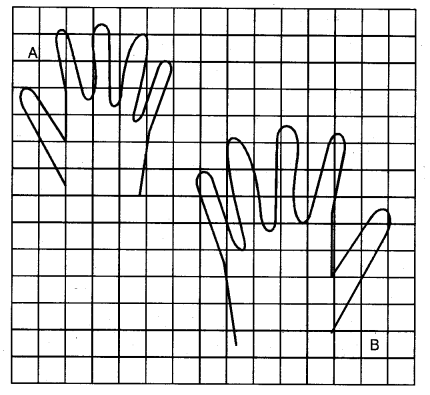
Method
On a squared sheet paper, trace your hand and your friend’s hand. . Count the number of complete squares, half filled squares, more than half filled squares and less than half filled squares.
Neglect the less than half filled squares.
Take the sum of complete squares and more than half filled squares to get the value of area.
For figure A: Number of complete squares = 6
Number of half filled Squares = 7
Number of more than half filled squares = 6
Area = 6 + 7/2 +6
= 6 + 3.5 + 6 = 15.5 square cm
For figure B: Number of complete squares = 13
Number of half filled squares = 4
Number of more than half filled squares = 13
Area = 13 + 6/2 + 13
= 13 + 3 + 13 = 29 square cm
NCERT Solutions for Class 5 Maths Chapter 3 Page 37
My Footprints
•Whose footprint is larger-yours or your friend’s?
•How will you decide? Discuss.
•Is the area of both your footprints the same?
My footprint is longer!
But my footprint is wider. So whose foot is bigger?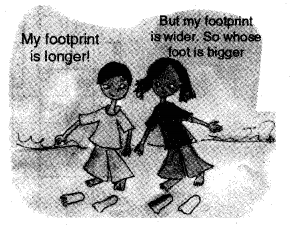
Ans. •My footprint is larger than my friend’s footprint.
•We can decide by finding the areas of these footprints.
•Yes, the area of both of my footprints is the same.
NCERT Solutions for Class 5 Maths Chapter 3 Page 38
1.Guess which animal’s footprint will have the same area as yours. Discuss.
Here are some footprints of animals-in actual sizes. Guess the area of their
footprints.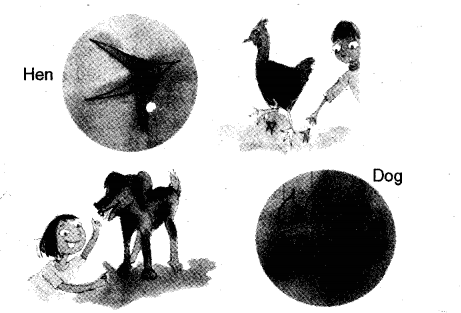
Ans. The footprint of a monkey may be similar in area as my footprint.
Area of hen’s footprint
= 3 square cm (approximately)
Area of dog’s footprint
= 10 square cm (approximately)
NCERT Solutions for Class 5 Maths Chapter 3 Page 39
1.Make big squares and rectangles like this to find the area faster.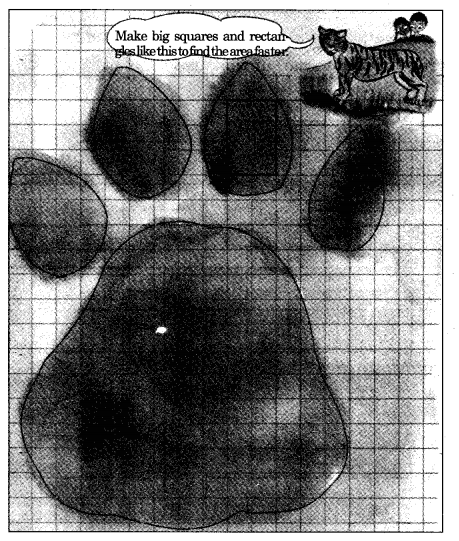
Ans. For (P) Area= 5 + 2/2 + 7
= 5 + 1 + 7 = 13 square cm
For (Q) Area = 7 + 2/2 + 4
= 7 + 1 + 4 = 12 square cm
For (R) Area = 6 + 0/2 + 9
= 6 + 9 = 15 square cm
For (S) Area == 4 + 0/2 + 6
= 4 + 6 = 10 square cm
For (T) Area = 96 + 4/2 + 21
= 96 + 2 + 21 = 119 square cm
NCERT Solutions for Class 5 Maths Chapter 3 Page 40
How Many Squares in Me?
1.What is the area of this triangle?
Ans. The area of this triangle = 1 square cm.
2.Is this shape half of the big rectangle?
Ans. Yes, this shape is half of the big rectangle.
3.The triangle is half the rectangle of area 2 square cm. So its area is square cm.
Ans. 1 square cm
4.Hmm———So its area is square cm.
Ans. 4 square cm.
5.Write the area (in square cm) of the shapes below: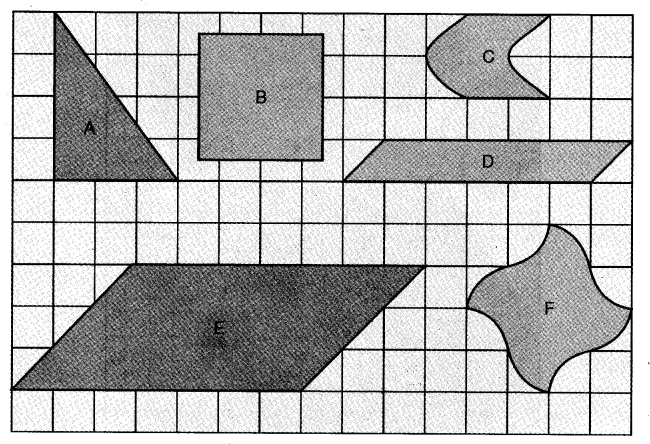
Ans.Area of triangle A = Half of area of rectangle
= 1/2 x 12 = 6 square cm.
Area of square B = 4 complete squares + 8 half squares + 4 quarter squares
= 4 + 1/2 x8 + 1/4 x 4
= 4 + 4 + l = 9 square cm
Area of shape C = 2 + 1/2 x 0 + 2
= 2 + 2 = 4 square cm
Area of shape D = 5 + 1/2 x 2 + 0
= 5 + 1 = 6 square cm
Area of shape E = 18 + 1/2 x 6 + 0
= 18 + 3 = 21 square cm
Area of shape F = 4 + 1/2 x 0 + 4
= 4 + 4 = 8 square cm.
NCERT Solutions for Class 5 Maths Chapter 3 Page 41
Try Triangles
Sameena: Both the big triangles in this rectangle have the same area.
Sadiq: But these look very different.
1.The blue triangle is half of the big rectangle. Area of the big rectangle is 20 square cm. So the area of the blue triangle is square cm.
Ans. Area of the blue triangle = 1/2 x 20 = 10 square cm
2.And what about the red triangle?
Ans. The area of red triangle is half of the area of rectangle.
Hence, area of red triangle = 10 square cm.
Ah, in it there are two halves of two different rectangles!
3.Now you find the area of the two rectangles Sadiq is talking about. What is the area of the red triangle? Explain.
Ans. Area of two rectangles = Area of red rectangle + area of green rectangle
= (3 x 4) + (4 x 2)
= 12 + 8 = 20 square cm Hence, area of red triangle together
= Half of area of both rectangles together
= 1/2 x 20 = 10 square cm.
Hence, both triangles have the same area.
4.Yes you are right. And you know what! You can draw many more triangles of area 10 square cm in this rectangle. Try drawing them.
Help Sadiq in finding some more such triangles. Draw at least 5 more.
Ans.
NCERT Solutions for Class 5 Maths Chapter 3 Page 42
Complete the Shape
1. Suruchi drew two sides of a shape. She asked Asif to complete the shape with two more sides, so that its area is 10 square cm.
Ans.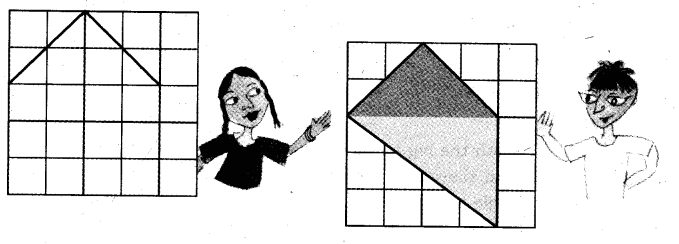
2.How did you do this?
Ans. Oh that’s easy ! If you look at the green area it is 4 square cm. Below it is the yellow area of 6 square cm. So the area of my shape is 10 square cm.
3.Is he correct? Discuss.
Ans. Yes, he is correct.
4.Explain how the green area is 4 square cm and the yellow area is 6 square cm.
Ans. Area of green portion = Number of complete squares + Number of half filled squares
=2+1/2 x 4 = 2 + 2 = 4 square cm
Area of yellow portion = Number of complete squares + Number of half filled squares + Number of more than half filled squares
=3 +1/2 x 2 + 2
= 3 + l + 2 = 6 square cm
NCERT Solutions for Class 5 Maths Chapter 3 Page 43
Suruchi : Oh, I thought of doing it differently! If you draw like this, the area is still 10 square cm.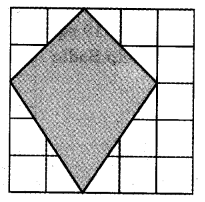
1.Is Suruchi correct? How much is the blue area? Explain.
Ans. Yes, Suruchi is correct.
Explanation: Area of green triangle
= Half of area of rectangle measuring 4 x 2 = 1/2 x 4 x 2
= 2 x 2 = 4 square cm
Area of blue triangle = Half of area of rectangle measuring 4×3 =1/2 x 4 x 3
= 2 x 3 = 6 square cm.
Hence, total area = 4 + 6 = 10 square cm
2.Can you think of some other ways of completing the shape? Try some other ways yourself.
Ans. We have read that the area of a triangle is half of area of a rectangle with same height and breadth.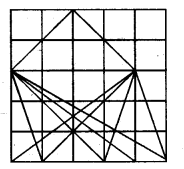
Hence, we can make a rectangle with area 12 square cm.
After that we can draw as many triangles in it as possible.
It is shown in the adjoining figure.
Practice Time
1.This is one of the sides of a shape. Complete the shape so that its area is 4 square cm.
Ans. Join two ends of the line to make a triangle. The area of this triangle can be calculated as follows:
Number of complete squares + Number of half filled squares
=1 + 1/2 x 2 =1+1=2/2
Now a mirror image of triangle can be created on the other side of the longest side so complete the rectangle. The area of this rectangle is 4 square cm.
2.Two sides of a shape are drawn here. Complete the shape by drawing two more sides so that its area is less than 2 square cm.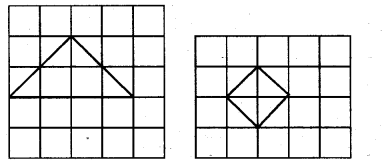
Ans. If two lines are joined, we get a triangle. The area of the triangle is 1 square cm. A mirror image of the triangle is drawn below the triangle to get a rectangle. The area of this rectangle is 2 square cm. Now, draw a point just above the bottom vertex of the rectangle and join the given sides with this point. This will give a rectangle with area less than 2 square cm.
3.Here is a rectangle of area 20 square cm.
(a)Draw one straight line in this rectangle to divide it into two equal triangles.What is the area of each of the triangles?
Ans.
A straight line can be drawn as shown in this figure to divide the rectangle into two equal triangles.
Area of each triangle = 1/2 x Area of rectangle = 1/2 x 20 =10 square cm
(b)Draw one straight line in this rectangle to divide it into two equal rectangles.What is the area of each of the smaller rectangles?
Ans.
A line can be drawn as shown in this figure to divide the given rectangle into two equal rectangles. Similarly, a horizontal line can also be drawn to divide the given rectangle into two equal rectangles.
Area of each smaller rectangle=1/2 x Area of bigger rectangle
1/2 x 20 = 10 square cm
(c)Draw two straight lines in this rectangle to divide it into one rectangle and two equal triangles.
What is the area of the rectangle?
What is the area of each of the triangles?
Ans.
Area of rectangle = 10 square cm
Area of each triangle = 1/2 x area of smaller rectangle
=1/2 x 10 =5 square cm
4.Every time guests come home, I ask them to do this. But why do they run away!
Ans. They may not be aware that this problem is so easy to solve.
NCERT Solutions for Class 5 Maths Chapter 3 Page 45
Puzzles With Five Squares
1.Measure the side of a small square on the squared paper. Make as many shapes as possible using 5 such squares. Three Eire drawn for you.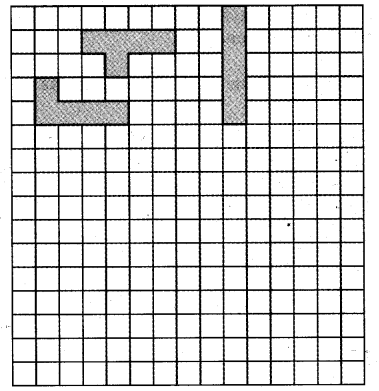
(a)How many different shapes can you draw?
Ans. 12 different shapes can be drawn using 5 such squares.
(b)Which shape has the longest perimeter? How much?———cm
Ans. The perimeter of all shapes (except fig no. 3) is 12 cm.
(c)Which shape has the shortest perimeter? How much?——–cm
Ans. The perimeter of shape 3 is the shortest.
(d)What is the area of the shapes?——— square cm. That’s simple!
Ans. Area of each shape is 5 square cm, because each of them is made of 5 similar squares.
NCERT Solutions for Class 5 Maths Chapter 3 Page 46-47
1.Draw all the 12 shapes on a sheet of cardboard and cut them.
Ans. Yes, I got all the 12 shapes using 5 squares. You can also draw them on a squared sheet paper or on a cardboard sheet.
2.Try to arrange your 12 shapes in some other way to make a 10 x 6 rectangle. Could you do it?
Ans. The side figure shows 12 shapes arranged in a different way to get a 10 x 6 rectangle.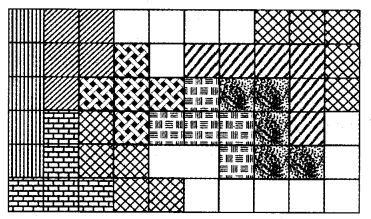
Try Another Puzzle
You have to make a 5 x 12 rectangle with these 12 shapes.
There are more than 1000 ways to do it. If you can find even one, that’s great!
Ans. The following figure shows one of the arrangements of 12 shapes to make a 5 x 12 rectangle.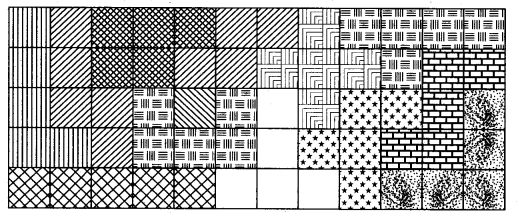
NCERT Solutions for Class 5 Maths Chapter 3 Page 48
Ziri went to a shop and was surprised to see the different designs of tiles on the floor.
Aren’t these beautiful!
Can you find the tile which is repeated to make each of these floor patterns? Circle a tile in each pattern.
After looking at the pattern Ziri wanted to make her own yellow tile. You too make a tile this way.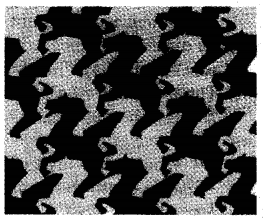
Step 1: Take a piece of cardboard or thick
paper. Draw a square of side 3 cm on it.
Step 2:Draw a triangle on any one of the sides of this square.
Step 3:Draw another triangle of the same size on another side of the square.
This triangle should be inside the square.
Step 4:Cut this shape from the cardboard. Your tile is ready! What is it’s
area?
Ans. The area is 3 x 3 = 9 square cm.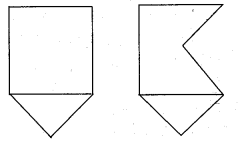
NCERT Solutions for Class 5 Maths Chapter 3 Page 49
Make a pattern using your tile. Trace the shape to repeat it on a page, but i remember there must be no gaps between them. Ziri made a pattern using her yellow tiles. (You know the area of her tile).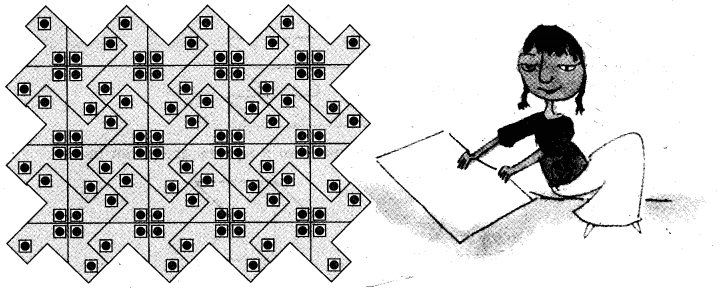
•How many tiles has she used?
Ans. She has used 12 tiles.
•What is the area of the floor pattern Ziri has made here?
Ans. Area = length x breadth
= 12 x 3 = 36 square cm
Practice Time
Ziri tried to make some other tiles.
She started with a square of 2 cm side and made shapes like these.
Look at these carefully and find out.
— Which of these shapes will tile a floor (without any gaps)? Discuss.
What is the area of these shapes?
— Make designs in your copy by : tiling those shapes.
— Now create your own new tiles out of a square. Can you do the same with a triangle? Try doing it.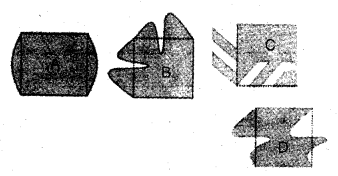
Ans. Shapes C and D will tile the floor without any gaps.
The area of these shapes = 2×2 = 4 square cm. Following designs can be made by using these shapes.
Design by using shape C: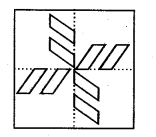
Design by using shape D: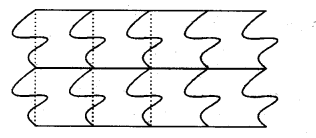
Some of the designs which can be made from a square are given below.











